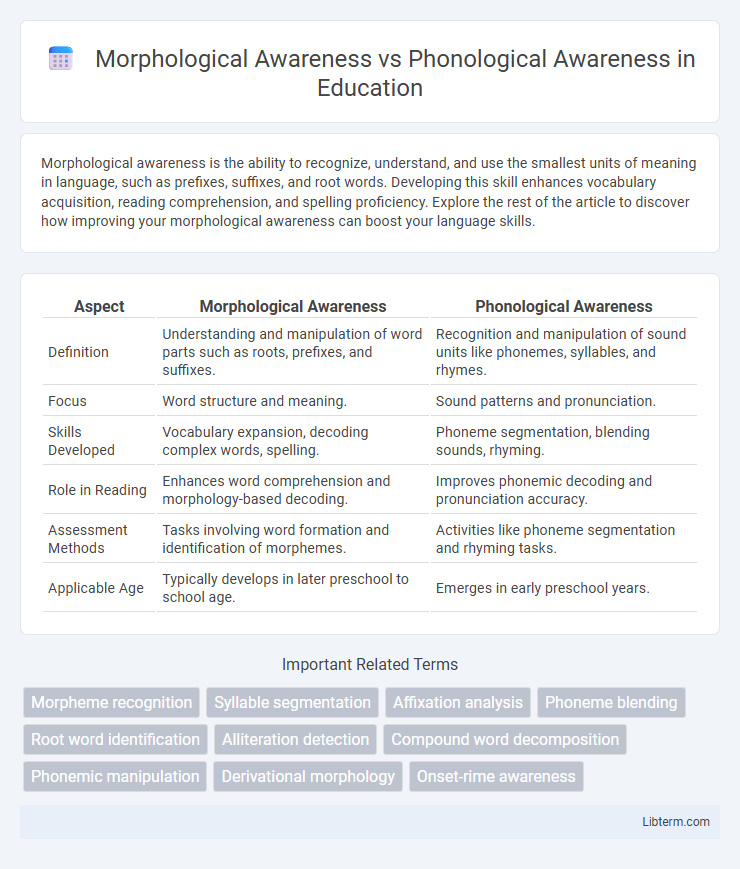Morphological awareness is the ability to recognize, understand, and use the smallest units of meaning in language, such as prefixes, suffixes, and root words. Developing this skill enhances vocabulary acquisition, reading comprehension, and spelling proficiency. Explore the rest of the article to discover how improving your morphological awareness can boost your language skills.
Table of Comparison
| Aspect | Morphological Awareness | Phonological Awareness |
|---|---|---|
| Definition | Understanding and manipulation of word parts such as roots, prefixes, and suffixes. | Recognition and manipulation of sound units like phonemes, syllables, and rhymes. |
| Focus | Word structure and meaning. | Sound patterns and pronunciation. |
| Skills Developed | Vocabulary expansion, decoding complex words, spelling. | Phoneme segmentation, blending sounds, rhyming. |
| Role in Reading | Enhances word comprehension and morphology-based decoding. | Improves phonemic decoding and pronunciation accuracy. |
| Assessment Methods | Tasks involving word formation and identification of morphemes. | Activities like phoneme segmentation and rhyming tasks. |
| Applicable Age | Typically develops in later preschool to school age. | Emerges in early preschool years. |
Introduction to Morphological and Phonological Awareness
Morphological awareness involves understanding and manipulating the smallest units of meaning in language, such as roots, prefixes, and suffixes, which supports vocabulary development and reading comprehension. Phonological awareness is the ability to recognize and manipulate the sound structures of spoken language, including phonemes, syllables, and rhymes, crucial for decoding words during reading. Both morphological and phonological awareness are essential foundational skills that contribute significantly to literacy acquisition and language proficiency in early education.
Defining Morphological Awareness
Morphological awareness involves understanding the structure of words and how morphemes--the smallest units of meaning such as roots, prefixes, and suffixes--combine to form complex words. This cognitive skill enables learners to decode, spell, and comprehend new vocabulary by analyzing the internal components of words rather than relying solely on sounds. Unlike phonological awareness, which focuses on recognizing and manipulating sounds at the syllable or phoneme level, morphological awareness emphasizes meaning-based word formation and grammatical relationships.
Understanding Phonological Awareness
Phonological awareness involves the ability to recognize and manipulate the sound structures of language, including phonemes, syllables, and rhymes, which forms a critical foundation for reading development. Skills such as segmenting, blending, and deleting sounds are essential components that support decoding and word recognition in early literacy. Mastery of phonological awareness enhances phonics understanding and contributes significantly to successful reading acquisition and fluency.
Key Differences Between Morphological and Phonological Awareness
Morphological awareness involves understanding and manipulating the smallest units of meaning in language, such as prefixes, suffixes, and root words, while phonological awareness focuses on recognizing and manipulating the sound structures of language, including phonemes, syllables, and rhymes. Morphological awareness supports vocabulary development and reading comprehension by enabling learners to decode complex words, whereas phonological awareness is crucial for decoding and encoding words during early reading acquisition. Key differences include the linguistic level each targets--morphological awareness deals with meaning-based units, whereas phonological awareness deals with sound-based units.
Role in Early Language Development
Morphological awareness enhances early language development by enabling children to understand the structure and meaning of words through prefixes, suffixes, and root words, which supports vocabulary growth and reading comprehension. Phonological awareness focuses on recognizing and manipulating sounds in spoken language, such as phonemes, syllables, and rhymes, which is critical for decoding skills and accurate word recognition in early reading. Developing both morphological and phonological awareness creates a strong foundation for literacy, facilitating efficient word learning and overall language proficiency in young learners.
Impact on Reading and Writing Skills
Morphological awareness, the understanding of word structure and formation, significantly enhances vocabulary development and reading comprehension by enabling readers to decode complex words and infer meanings. Phonological awareness, the ability to recognize and manipulate sound units in language, plays a crucial role in early reading skills, particularly in phonics and decoding unfamiliar words. Both skills contribute uniquely to writing proficiency, with morphological awareness improving spelling and word choice, while phonological awareness supports accurate sound-letter correspondences.
Assessment Strategies for Morphological and Phonological Awareness
Assessment strategies for morphological awareness include tasks that require identifying and manipulating morphemes, such as prefix, suffix, and root word analysis, as well as word-building exercises and morphological structure sorting. Phonological awareness assessment focuses on skills like phoneme segmentation, blending, rhyming, and sound deletion, often measured through auditory discrimination tasks and phoneme manipulation activities. Utilizing both types of assessments provides a comprehensive understanding of language processing skills essential for effective literacy instruction.
Instructional Approaches for Building Awareness
Instructional approaches for building morphological awareness emphasize teaching word structure through root words, prefixes, and suffixes, helping students understand meaning and word formation. In contrast, phonological awareness instruction focuses on recognizing and manipulating sound units such as phonemes, syllables, and rhymes using activities like segmenting and blending sounds. Combining both approaches enhances overall literacy skills by integrating morphological patterns with sound analysis techniques tailored to students' developmental levels.
Challenges in Teaching Morphological vs Phonological Skills
Teaching morphological awareness presents challenges due to the complexity of understanding root words, prefixes, and suffixes, which require explicit instruction and often abstract reasoning. Phonological awareness instruction is generally more straightforward as it involves recognizing and manipulating sounds within words, but students with auditory processing difficulties may struggle. Both skills demand differentiated approaches to address individual learner needs and ensure effective language development.
Conclusion: Integrating Both Awareness for Literacy Success
Integrating morphological awareness with phonological awareness enhances literacy development by combining skills in understanding word structure and sound patterns. Research shows that this dual approach improves reading comprehension, vocabulary acquisition, and spelling accuracy more effectively than focusing on either skill alone. Educational programs emphasizing both morphological and phonological strategies lead to higher literacy success rates in diverse learner populations.
Morphological Awareness Infographic

 libterm.com
libterm.com